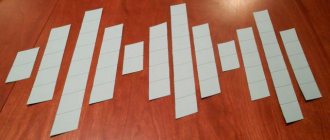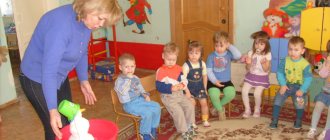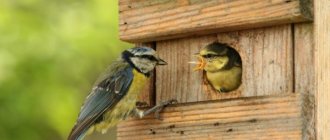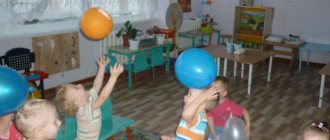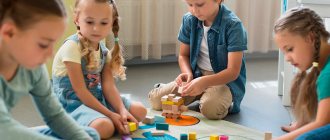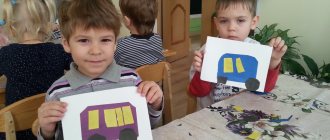MAGAZINE Preschooler.RF
Card index of games using TRIZ technology, first junior groupAuthor's development teacher: Tkachenko E.A.
1. Didactic game: “Relief sign and hand analyzer”
(Balls in relief)
Goal: To develop in children the ability to independently examine an object to determine the meaning of a sign. We determine the name of the feature using the hand analyzer.
Objectives: Development of children's cognitive abilities in the process of joint research activities;
Develop observation skills;
To introduce children of primary preschool age to the sign “relief” and its meanings;
Progress of the game:
Q: Guys, what sign is shown on the box?
D: Relief.
Q: Which smart head assistant will help us determine the topography of an object?
D: Hand.
Q: Look at the balls in the box.
Let's determine which ball is based on its relief?
D: (smooth), (prickly).
Q: Which smart head assistant helped us determine the relief of objects?
D: Hand.
Q: The hand touches, and the smart head sees and understands what kind of relief the ball is.
Thanks guys!
2. Didactic game: “Humidity sign and hand analyzer”
(handkerchief)
Goal: To develop in children the ability to independently examine an object to determine the meaning of a sign. We determine the name of the feature using the hand analyzer.
Objectives: Development of children's cognitive abilities in the process of joint research activities;
Develop observation skills;
To introduce children of primary preschool age to the sign “humidity” and its meanings;
Progress of the game:
Q: Guys, what sign is shown on the box?
D: Humidity.
Q: Which smart head assistant will help us determine the humidity of an object?
D: Hand.
Q: Look at the handkerchiefs in the box.
Let's determine which handkerchief by moisture content?
D: (dry), (wet, damp).
Q: Which smart head assistant helped us determine the humidity of objects?
D: Hand.
Q: The hand touches, and the smart head sees and understands the moisture level of the handkerchief.
Thanks guys!
3. Didactic game: “Color sign and eye analyzer”
(Masha and her plates)
Goal: To develop in children the ability to independently look to find out the meaning of a sign. We determine the name of the feature using the eye analyzer.
Objectives: Development of children's cognitive abilities in the process of joint research activities;
Develop observation skills;
To introduce children of primary preschool age to the sign “color” and its meanings;
Progress of the game:
Q: Guys, what sign is shown on the box?
D: Color.
Q: Which smart head assistant will help us determine the color of an object?
D: Eyes.
Q: Look at the multi-colored plates in the box.
Let's help Masha identify which plates by color?
D: (blue), (red), (green), (yellow).
Q: Which smart head assistant helped us determine the color of objects?
D: Eyes.
Q: The eyes look, but the smart head sees and understands the color of the plate.
Thanks guys!
4. Didactic game: “Color sign and eye analyzer”
(Flowers and butterflies)
Goal: To develop in children the ability to independently look to find out the meaning of a sign. We determine the name of the feature using the eye analyzer.
Objectives: Development of children's cognitive abilities in the process of joint research activities;
Develop observation skills;
To introduce children of primary preschool age to the sign “color” and its meanings;
Progress of the game:
Q: Guys, what sign is shown on the box?
D: Color.
Q: Which smart head assistant will help us determine the color of an object?
D: Eyes.
Q: Look in the envelope for multi-colored (four-color) flowers and butterflies of the same color. Let's help the butterflies find a flower by color.
D: (blue), (red), (green), (yellow).
Q: Which smart head assistant helped us determine the color of objects?
D: Eyes.
Q: The eyes look, but the smart head sees and understands the color of the butterfly and flower.
Thanks guys!
5. Didactic game: “Sign color and eye analyzer”
(Like a cockerel choosing its own color).
Goal: To develop in children the ability to independently look to find out the meaning of a sign. We determine the name of the feature using the eye analyzer.
Objectives: To clarify children’s knowledge about colors: red, yellow, green, blue. Encourage children to fantasize based on changing the values of the “Color” .
Progress of the game:
Q: Guys, what sign is shown on the box?
D: Color.
Q: Which smart head assistant will help us determine the color of an object?
D: Eyes.
Q: The Cockerel (colorless silhouette) came to visit us.
D: The children greet him and get to know him.
Q: He notes that the Cockerel is white and asks the children how to make him beautiful (listens to all the options without comments).
I suggest you send Cockerel for a walk along the “magic path” .
D: Children name the colors that live on this path.
Q: The cockerel walks along the path and is painted in the appropriate color.
The Cockerel asks the children to bring toys of the appropriate color, name the toy and its color. The teacher generalizes that all toys are red.
The cockerel asks the children to find the color red in the children's clothes.
Q: Which smart head assistant helped us determine the color of objects?
D: Eyes.
Q: The eyes look, but the smart head sees and understands the color of objects (cockerel, path, toys).
At the end of the lesson, the cockerel thanks the children for making him beautiful, elegant, and colorful.
| Next > |
TRIZ games in the development of children of primary and preschool age
The practice of recent years shows that the use of the method of the theory of solving inventive problems, used for the development of children of primary and preschool age, is one of the most frequently used and effective.
TRIZ technology itself is aimed at creating conditions in which a child will find a way to solve a problem not by trial and error, but by the method of value judgments. The most common and easiest to use are game forms of the TRIZ : Identification of the functions of an object, its characteristics, properties, etc.
This method of use does not entail any complex preparations for the gameplay; imagination and approach are more important here. By giving the child the opportunity to reason and think on his own during the game, we will thereby improve his mental capabilities and value judgments, which will ultimately be the main means of cognition. Let's look at an example of such a game:
1 “What can he do?” (game for children from 3 years old)
Rules of the game: The presenter names the object. Children must determine what an object can do or what can be done with its help.
Approximate move:
B: Tape recorder.
D: Can break, can play music, play radio, record music
songs, turn on, turn off, glow.
2 “Good or bad” (game for younger preschool age). Goal: To teach children to make value judgments and reasoning about the world around them.
Rules of the game:
A leader is any object whose positive and negative properties are determined.
Progress of the game.
Q: Riding a bike is good. Why?
D: Because it’s fun.
B: Ride a bike. Why?
D: You can fall.
That is, questions are asked according to the principle: “if it’s good, then why?”, “if it’s bad, then why?”
Also in this game, questions can be asked in a chain based on the children’s answers to the first question asked.
Using this method, you can come up with various variations of this game, for example, “Who lives where,” “What happened before, what later,” etc. Once again we are convinced that in this matter the approach to children and the imagination of the teacher himself are more important.
In the same way, Lull circles as one of the tools for sensory knowledge of the world through the formation of object characteristics. For example:
Q: Guys, look at the “magic circles”. Who do you see in the pictures?
D: - These are animals
D: - List the animals
B: - Correct. On the circles are pictures of animals and the place where they live. Today we will talk about them
Q: The first game I suggest you play is called “Who Lives Where?” But first, I’ll ask a riddle, whoever answers first will spin circles.
D: — What should you do in this game?
Q: - You need to name the animal in the picture that falls under the arrow on the large circle, select and name on the second circle the place where it lives.
As we see, the games are quite variable and will perfectly develop thinking, evaluative and cognitive activity in children, which is what the entire methodology for using TRIZ technology is generally aimed at.
